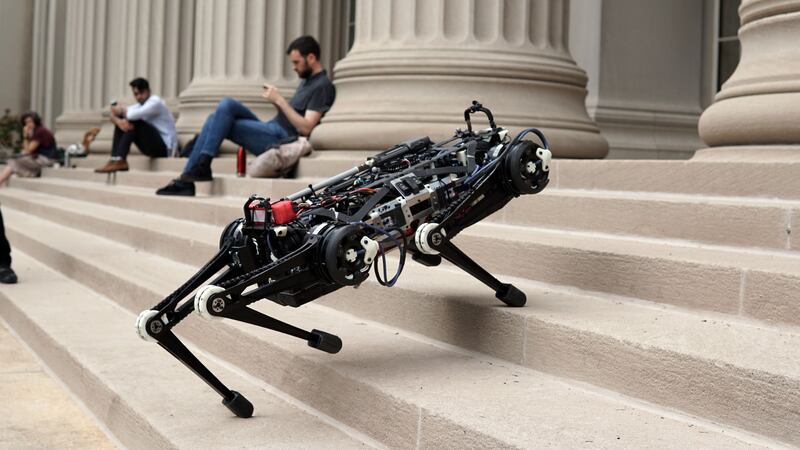Researchers in the US have developed a new version of their “Cheetah” robot dog that can climb a staircase and navigate obstacles “essentially blind”.
Engineers at the Massachusetts Institute of Technology (MIT) said the Cheetah 3 prototype can “leap and gallop across rough terrain, climb a staircase littered with debris and quickly recover its balance when suddenly yanked or shoved” – without the use of cameras.
It is an upgraded version of the predecessor Cheetah 2, and is designed to do “versatile tasks such as power plant inspection, which involves various terrain conditions including stairs, kerbs and obstacles on the ground”, according to the team.
The 90lb (41kg) robot – which the researchers say as about the size of a fully-grown Labrador – navigates its environment by touch, using machine-learning technology.
The team developed two algorithms: contact detection – which helps the robot determine the best time for a given leg to switch from swinging in the air to stepping on the ground – and model-predictive control – which predicts how much force a given leg should apply once it has committed to a step.
Sangbae Kim, associate professor of mechanical engineering at MIT and one of the robot’s designers, said: “The contact detection algorithm will tell you ‘This is the time to apply forces on the ground’.
“But once you’re on the ground, now you need to calculate what kind of forces to apply so you can move the body in the right way.”
The algorithms are designed to make calculations for each leg every 50 milliseconds – around 20 times per second – and work much like the human brain.
Prof Kim said: “If humans close our eyes and make a step, we have a mental model for where the ground might be, and can prepare for it. But we also rely on the feel of touch of the ground.
“We are sort of doing the same thing by combining multiple (sources of) information to determine the transition time.”
Explaining why the team chose not to include visual sensors in their algorithms, Prof Kim said: “There are many unexpected behaviours the robot should be able to handle without relying too much on vision.
“Vision can be noisy, slightly inaccurate, and sometimes not available, and if you rely too much on vision, your robot has to be very accurate in position and eventually will be slow.
“So we want the robot to rely more on tactile information. That way, it can handle unexpected obstacles while moving fast.”
He believes robots like Cheetah 3 could be used in situations that are deemed too dangerous for humans.
Prof Kim said: “I think there are countless occasions where we (would) want to send robots to do simple tasks instead of humans. Dangerous, dirty and difficult work can be done much more safely through remotely controlled robots.”
The design will be presented at the International Conference on Intelligent Robots in Madrid, Spain, in October.









